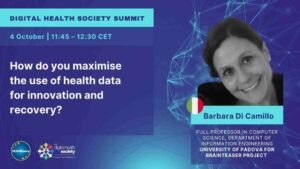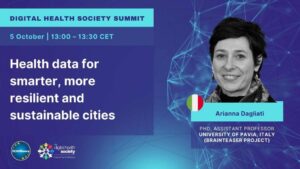BRAINTEASER contribution to the DHSS 2022
The Digital Health Society Summit 4th edition, that took place virtually on October 4th and 5th 2022, has seen the contribution of BRAINTEASER in two relevant panel discussions: “How do you maximise the use of Health data for innovation and recovery?” and “Health data for smarter, more resilient and sustainable cities”.
This year edition of the Summit, that has counted almost 1000 registrations and more than 400 active interactions during the 2 days event, has been focussed the topic “Data & Digital services to support the recovery of health systems across the globe” which is one the 3 themes of the Global Health Connector Partnership Flagship events in 2022 in the US (Boston, Las Vegas and Washington), India (New Delhi), Africa (Kenya), Spain (Barcelona) and Switzerland.
On October 4th, Barbara Di Camillo, Full Professor in Computer Science, Department of Information Engineering at the University of Padova (IT) and BRAINTESER’s Scientific Manager, has actively participated to the session aimed at exploring the importance of health data. The panel discussion has been focussed on the evidence that updated and high-quality health data is a key asset to shape health policies and provide citizens with tools and medicines that are effective and contribute for their wellbeing, but still there are a number of challenges that need to be overcome to access, use and re-use them.
 Based on her previous experiences, acquired knowledge and work done in BRAINTEASER, Barbara’s reflections shared with the Summit speakers and audience were:“Many Artificial Intelligence (AI) applications, and in particular Machine Learning applications are based on data, meaning that they are learning from data and, in general, the more data they have, the better they learn and perform in terms of prediction accuracy. More importantly, to be used in practical life, AI applications need to be able to generalize, to perform well on different populations or even on underrepresented categories to avoid the so-called AI bias. BRAINTEASER solutions learn from data collected in the hospitals. Therefore, compared to trial data, they are much more representative of the real-life population. On the other hand, since for example Amyotrophic Lateral Sclerosis (ALS) is a rare disease, data sharing is important to guarantee solutions that are sustainable and useful. In BRAINTEASER we make use of public data and we make (fully anonymized) data available within public challenges organization in which one or more datasets are shared and the scientific community is called first to compete and then to collaborate trying to address a specific problem. These initiatives, beside sharing data, share solutions, software and results and create a community around a problem.
Based on her previous experiences, acquired knowledge and work done in BRAINTEASER, Barbara’s reflections shared with the Summit speakers and audience were:“Many Artificial Intelligence (AI) applications, and in particular Machine Learning applications are based on data, meaning that they are learning from data and, in general, the more data they have, the better they learn and perform in terms of prediction accuracy. More importantly, to be used in practical life, AI applications need to be able to generalize, to perform well on different populations or even on underrepresented categories to avoid the so-called AI bias. BRAINTEASER solutions learn from data collected in the hospitals. Therefore, compared to trial data, they are much more representative of the real-life population. On the other hand, since for example Amyotrophic Lateral Sclerosis (ALS) is a rare disease, data sharing is important to guarantee solutions that are sustainable and useful. In BRAINTEASER we make use of public data and we make (fully anonymized) data available within public challenges organization in which one or more datasets are shared and the scientific community is called first to compete and then to collaborate trying to address a specific problem. These initiatives, beside sharing data, share solutions, software and results and create a community around a problem.
Of course, an issue is data anonymization. From the technical point of view there are different guidelines that can be used to prevent subject identification and also a number of algorithms that tell us how much noise to add to the data to guarantee anonymization. However, when different datasets are merged, sometimes additional noise has to be added. Think for example to geolocalization data. Even if the subject is anonymous, knowing where he/she spends the most of his/her time might help guessing who he/she is. There are solutions also to this aspect, because we can refer geo-data to virtual rather than real places (this is also the approach taken by BRAINTEASER), but additional attention has to be paid to guarantee full anonymization in these cases.
There are other difficulties that are of administrative type. At present, in many institutions one single person must take the responsibility of guaranteeing full anonymization and this creates a situation in which the institutions are cautious about data sharing. I think that, as civil society, we need to consider also the costs of not using the data. We need new policies that clarify which is the process of data anonymizations and share the responsibility across different steps of which different people are in charge”.
 On the second day of the Summit, Arianna Dagliati, PhD, Assistant Professor at the University of Pavia (IT) was involved in the discussion on how health data can be used by European cities to build their intelligence
On the second day of the Summit, Arianna Dagliati, PhD, Assistant Professor at the University of Pavia (IT) was involved in the discussion on how health data can be used by European cities to build their intelligence
and resilience.
Arianna, who is currently actively contributing to the BRAINTEASER activities for the definition and implementation of algorithms for extracting patterns from different data, including the environmental ones, presented the Pavia experience and its infrastructure to track personal exposure to pollutants.
During her presentation, Arianna put particular emphasis on its exploitation within two EU projects PULSE and BRAINTESER: “Technological framework such as the one implemented in Pavia facilitate the shift to a collaborative system and citizen engagement where the players can be both (i) citizen, which are engaged in the process while keeping track of their activities and generate data about their exposure with finer granularities (ii) the public health stakeholders, who have data about general health of the population and can use the data generated by these framework for population assessments and for the evolution of specific health risks.
BRAINTEASER aims to exploit the value of data related to health, lifestyle habits, and environment, to support Amyotrophic Lateral Sclerosis and Multiple Sclerosis patients, leverage this framework and extend it. Taking advantage of the Pavia framework (i.e. cost-efficient fine sensor grid coupled with clinical data) BRAINTEASER can develop AI models to study how environmental factors and personal exposure profiles can impact on the course of diseases. So, to reach one of the project’s main goals: to anticipate and manage the impacts of risk factors contributing to neurodegenerative diseases’ complications, and poor prognosis.
As for any other “good” model, a framework such as the Pavia’s one should be easily exported and re-implemented into other contexts. The Pavia framework, for acquiring personal exposure data, has been implemented within BRAINTEASER pilots cities and for different studies cohorts: (i) the strategies to acquire data can been adapted according to the different cities features (dimension, city morphology…) and local initiatives to acquire environmental data; (ii) the health risk studies can benefit from the possibility to set up different settings accordingly to sub-population characteristics and levels of disabilities, for example including the usage of portable devices and/or indoor sensors”.
